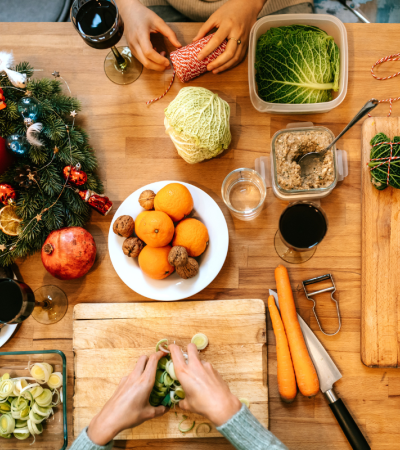The No-Bake Gingerbread House Workshop is an all-ages, hands-on experience where each participant creates their own edible house to take home.
Advanced Planning
Through this program, participants strengthened their design skills while exercising creativity and problem-solving to construct their gingerbread houses. Youth participants built essential skills such as following instructions, critical thinking and adaptability.
Planning for this system-wide program began four to six months in advance to ensure coordination with staff at each location. A Library Services Coordinator and an Information Professional planned and hosted the event at five of the seven locations in the system while branch staff at two locations elected to host on their own. To prepare, we assembled pre-made kits that were delivered to participating locations and coordinated dates to offer patrons a variety of scheduling options. Estimated attendance was determined using program statistics, and we managed registration through our LibCal calendar system to ensure adequate supplies.
We created a mock-up of the project in advance with detailed notes on the process and materials needed. We developed two sets of instructions—one for staff facilitating the program and one for patrons. The patron instructions were image-rich to make them accessible and easy to follow for all ages.
Marketing
Leon County’s Community and Media Relations department promoted the program by posting it to the library's online calendar, sharing it on social media and creating flyers. All locations created baking-themed book displays to help promote the event. The marketing was successful as each program was close to capacity or fully booked, and we even had to turn away drop-ins at one of the programs.
Budgeting
Our budget was set for seven locations, with approximately $80 allocated to each site. To keep costs down, we limited the amount of extra candy purchased for decorating the houses and used supplies already available at each branch. While we used disposable piping bags, we could have substituted plastic sandwich bags. Instead of using whole eggs, we opted for egg whites from a carton. While slightly more expensive, they saved staff time, reduced waste from ruined batches, and made the process easier for staff members with limited baking experience.
Altogether, we served 182 patrons at an average cost of about $3 per person. With the exception of the egg whites, most materials were shelf-stable and could be saved for future programs.
Day-of-event Activity
On the day of the workshop, we made the royal icing at least two hours before the event. One staffer made the icing and loaded it into piping bags, which were stored in the fridge until needed.
An hour before the event, a staffer set up the program room with tables and chairs for all attendees, ensuring each station had the necessary supplies: a piping bag with icing, graham crackers, a plastic butter knife, instructions and a cake board. Additionally, candy cups and paper towels were placed between stations. At the host's station, extra graham crackers, scissors and printed instructions were ready. The room was also prepared with hand sanitizer, music and optional holiday decorations.
Fifteen minutes before the workshop began, two staff cut the tips of the icing bags and tested them. As attendees arrived, staff confirmed registrations, invited them to wash their hands or use hand sanitizer, and ensured everyone was ready to start. The host did a quick welcome and demonstration before letting the attendees work on their own. During the workshop, staff provided one-on-one assistance to attendees. Attendees participated in clean up during the last 15 minutes.
Program Execution
Registration filled quickly and most of our locations reached their maximum capacity based on the number of house kits available. The 1.5-hour program length proved to be just right, allowing participants enough time to build and decorate without feeling rushed. Attendees appreciated that the event was open to all ages, making it a fun and inclusive family activity. There was, however, some initial confusion about registration, as some patrons did not realize that sign-ups were per house kit rather than per individual seat. Despite that minor issue, the program was a success across a wide range of neighborhoods, with a total of 182 participants system-wide. Even branches that had previously struggled with program attendance saw strong turnout. Patron feedback was overwhelmingly positive—one attendee shared that the event “brought our family and community together,” while another said it created lasting memories.
Advice
Cover tables with paper or plastic tablecloths for easy cleanup. To set the mood, play copyright-free, non-religious holiday music and project a cozy winter scene. We initially advertised the event for youth but learned that adults enjoy it just as much, so now we promote it as an all-ages program.
Plan for at least one staff member per 10-12 attendees so there’s enough support for hands-on help. We also learned not to break the demonstration into sections as people naturally move ahead at their own pace and trying to pause them only caused confusion. Invite attendees to help clean up during the last 15 minutes.
When it comes to supplies, use fresh, plain graham crackers. Cinnamon flavored crackers seemed to break more easily. Avoid nuts and other common allergens. Encourage everyone to wash their hands or use hand sanitizer before getting started. Provide cardboard cake boards for each house, since they make construction and transport much easier.
Allow groups to build a house together. If you require registration, be sure to clarify that it’s one registration per house kit, not per attendee. Finally, have a sample house pre-made so participants can see what the finished product looks like.




